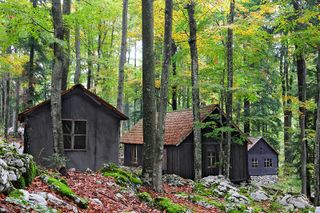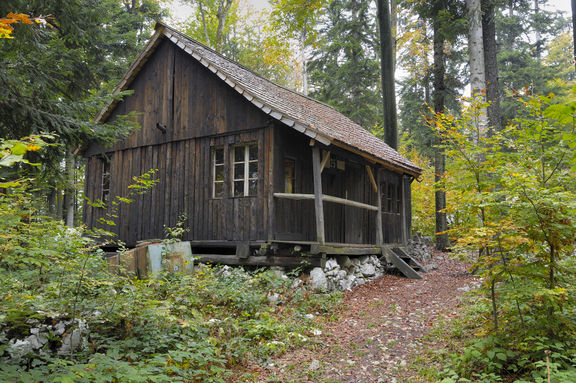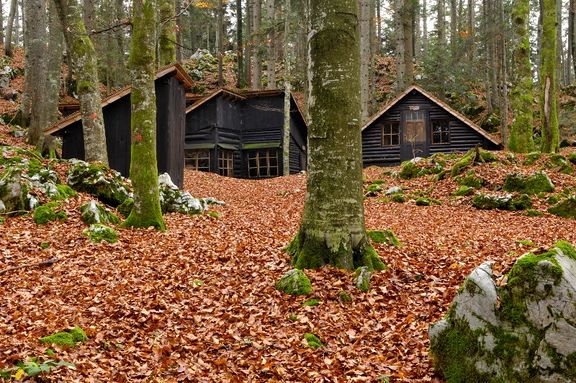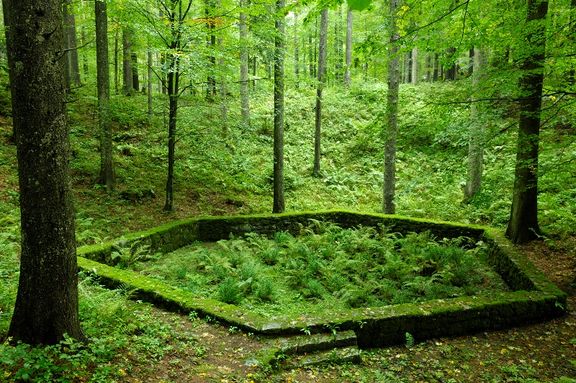Difference between revisions of "Baza 20 Memorial Site, Kočevski Rog"
(Created page with '{{Infobox |Name=Spomeniško območje Baza 20 |Street=Kočevski rog, next to Dolenjske toplice |Town=SI-8000 Novo mesto |Website= http://www.dolmuzej.com/ |Manager= Dolenjska Muse...') |
(added War memorials using HotCat) |
||
| (75 intermediate revisions by 12 users not shown) | |||
| Line 1: | Line 1: | ||
| + | {{Article | ||
| + | | status = PHOTO COVER | ||
| + | | maintainer = Ivan Pirnat | ||
| + | }} | ||
| + | |||
{{Infobox | {{Infobox | ||
| − | | | + | | logo = Dolenjska Museum Novo mesto (logo).svg |
| − | | | + | | name = Baza 20 Memorial Site, Kočevski Rog |
| − | | | + | | local name = Kočevski Rog - Baza 20 |
| − | | | + | | street = Kočevski rog |
| − | | | + | | town = SI-8000 Novo mesto |
| − | | | + | | telephone = 386 (0) 7 306 6025, 386 (0) 41 315 165 |
| − | {{Contact | + | | fax = 386 (0) 7 373 1112 |
| − | | | + | | email = baza.20@dolenjskimuzej.si |
| − | | | + | | website = http://www.dolenjskimuzej.si/si/lokacije/kocevski-rog/ |
| − | | | + | | managed by = Dolenjska Museum Novo mesto |
| − | | | + | | opening hours = From 1 April to 31 October between 10am-6pm Tue-Sun, closed Mon and holidays, groups by appointment |
| + | | map = http://www.openstreetmap.org/?lat=45.69734&lon=15.048969&zoom=18 | ||
| + | | contacts = {{Contact | ||
| + | |name = | ||
| + | |role = | ||
| + | | email = | ||
| + | | telephone = | ||
| + | }} | ||
}} | }} | ||
| − | | | + | |
| + | {{Teaser| | ||
| + | |||
| + | [[File:Kočevski Rog Baza 20.jpg|320px]] | ||
| + | |||
| + | [[Baza 20 Memorial Site, Kočevski Rog|Baza 20]] was one of the numerous camps in the woods of Kočevski Rog which were once the commanding structures of the National Liberation Movement of Slovenia in the Second World War. Numerous secretively built partisan structures and settlements scattered in the Kočevski Rog forest had the code name ''Baza'' plus number: 15, 15a, 21, 80, etc. Only Baza 20 and the field hospitals Jelendol and Zgornji Hrastnik have been preserved as monuments of national and cultural heritage and have also undergone extensive restoration work. | ||
| + | |||
| + | This former base camp (''baza''), which was granted the status of a cultural and historical monument of national importance in [[established::1952]], has been managed by the [[Dolenjska Museum Novo mesto|Dolenjska Museum]] in Novo mesto since 1994. | ||
}} | }} | ||
| + | In 1995 a permanent exhibition in Barrack 16 was set up, while a second exhibition has been on display in Barrack 22 since 1998 presenting the activities of the partisans including their workshops, hospital, and the operations of the Slovene National Liberation Council in Kočevski Rog. By appointment visitors can also watch a short introductory documentary on Baza 20 in Lukov Dom near the site. | ||
| − | + | ==History== | |
| − | + | Already in August 1941, the first resistance against Italian and German occupational forces was organised in this region. Kočevski Rog was the first part of Slovenia to be liberated under partisan command as early as May 1942. At that time, it became the logistic centre of the armed resistance. Partisan hospitals, workshops, schools, printing works, and warehouses were soon operating in these deep woods during the war. | |
| − | }} | + | |
| + | From April 1943 the most important headquarters were in Baza 20: the seat of the Central Committee of the Communist Party of Slovenia and the Executive Committee of the Liberation. At the end of 1943, 26 barracks housed some 140 fighters and politicians, among them also [[Edvard Kocbek]] and [[Boris Kidrič]]. | ||
| + | |||
| + | ==See also== | ||
| + | * [[Dolenjska Museum Novo mesto]] | ||
| + | |||
| + | ==External links== | ||
| + | * [http://www.dolenjskimuzej.si/si/lokacije/kocevski-rog/ Baza 20 web page] | ||
| + | * [http://www.burger.si/MuzejiInGalerije/DolenjskiMuzej/Baza20/Baza20_ENG.html Baza 20 on Burger.si], [[Virtual Guide to Slovene Museums and Galleries]] | ||
| + | * [http://en.wikipedia.org/wiki/Liberation_Front_of_the_Slovenian_People Liberation Front of the Slovenian People on Wikipedia] | ||
| + | * [http://en.wikipedia.org/wiki/Slovenian_National_Liberation_Council Slovenian National Liberation Council on Wikipedia] | ||
| + | * [http://en.wikipedia.org/wiki/Yugoslav_Partisans Yugoslav Partisans on Wikipedia] | ||
| + | |||
| + | {{gallery}} | ||
| + | |||
| + | [[Category:Museums]] | ||
| + | [[Category:Monuments and sites]] | ||
| + | [[Category:Venues]] | ||
| + | [[Category:World War II]] | ||
| + | [[Category:War memorials]] | ||
Latest revision as of 20:17, 25 July 2020
In 1995 a permanent exhibition in Barrack 16 was set up, while a second exhibition has been on display in Barrack 22 since 1998 presenting the activities of the partisans including their workshops, hospital, and the operations of the Slovene National Liberation Council in Kočevski Rog. By appointment visitors can also watch a short introductory documentary on Baza 20 in Lukov Dom near the site.
History
Already in August 1941, the first resistance against Italian and German occupational forces was organised in this region. Kočevski Rog was the first part of Slovenia to be liberated under partisan command as early as May 1942. At that time, it became the logistic centre of the armed resistance. Partisan hospitals, workshops, schools, printing works, and warehouses were soon operating in these deep woods during the war.
From April 1943 the most important headquarters were in Baza 20: the seat of the Central Committee of the Communist Party of Slovenia and the Executive Committee of the Liberation. At the end of 1943, 26 barracks housed some 140 fighters and politicians, among them also Edvard Kocbek and Boris Kidrič.
See also
External links
- Baza 20 web page
- Baza 20 on Burger.si, Virtual Guide to Slovene Museums and Galleries
- Liberation Front of the Slovenian People on Wikipedia
- Slovenian National Liberation Council on Wikipedia
- Yugoslav Partisans on Wikipedia









![Baza 20 [Base 20] served April 1943 - December 1944 as the living quarters for the political leadership of the Slovenian national liberation movement and represents an important monument to Slovenia’s statehood.](/images/thumb/c/c7/Baza_20_Memorial_Site_Kocevski_Rog_2005_Photo_Marko_Prsina.jpg/576px-Baza_20_Memorial_Site_Kocevski_Rog_2005_Photo_Marko_Prsina.jpg)